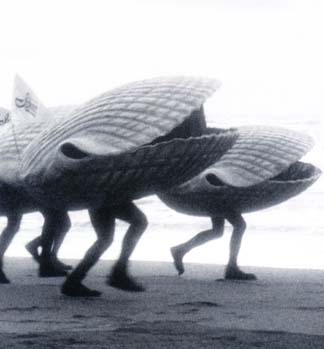 I find myself thinking about the word ‘clam’ more often than is decent, at least without some thought. I call certain pairs of pants ‘clamdiggers’, even though I’ve never worn them to do such a thing. When I scrounge around to find dollar bills in pockets and drawers—and then these clams disappear quickly into other pockets and piggybanks—I really do feel like I’m shelling out. And this morning, watching a new reader engrossed in a book with a contented, close-lipped smile, the first thing that I thought was, he really is as happy as a clam.
I find myself thinking about the word ‘clam’ more often than is decent, at least without some thought. I call certain pairs of pants ‘clamdiggers’, even though I’ve never worn them to do such a thing. When I scrounge around to find dollar bills in pockets and drawers—and then these clams disappear quickly into other pockets and piggybanks—I really do feel like I’m shelling out. And this morning, watching a new reader engrossed in a book with a contented, close-lipped smile, the first thing that I thought was, he really is as happy as a clam.
So I thought I’d find out more about them, those shellfish that bear so much metaphorical weight. What if clams have grumpy days, too?
I’ve always thought of clams, and clam digging, as an east coast thing, something you do in your clamdiggers when you go to the shore. Turns out we have lots of them in the eastern Pacific, too, including the giant geoduck, the reportedly tasty Pacific razor clam, even the Manila clam, which rode in on Japanese oyster seeds. Near me, there was once a thriving fishery for the Pismo clam, a beautiful-looking bivalve. People used horse-drawn plows to rake the beaches for them, harvesting 6.25 million pounds between 1916 and 1947, when commercial fishing was banned.
People still dig for them with big-tined forks, or find them with their feet doing the “clam shuffle” at low tide. Clammers have been clamming here for quite a long time; shells from clams (including Pismo clams, which now range from the Monterey Bay down to Socorro Island, south of Baja) have been found in middens along the coast
Many cultures, including some groups that lived along this coast, used clam and other shells as currency–which is why my sadly wrinkled laundry dollar bills can get such a hard-shelled nickname. I also read more about those cheerful-sounding clams, and learned that the complete expression is happy as a clam when the tide is high. And it’s true, when I do think of someone who’s happy as a clam, I do think of a feeling of perceived safety, whether the water is nicely up above your shell or your head is nicely in a book.
Unfortunately for literal, littoral clams, high water isn’t an end to their worries–people dive for them, too. And sharks, bat rays, otters, crabs, and other predators don’t care that the waterline has moved up the beach. Some crabs can crack a Pismo clam open with their pinchers, while moon snails drill holes through a clam’s shell with their saw-like tongues. Bat rays can even use their wings like plungers, creating a suction force on the sand that hoovers up Pismo clams.
Oh, happiness: to be on the toilet-bowl end of the plumbers’ helper! We think of the clam curled up beneath the sand, cozily protected in its shell, maybe even having an enigmatic smile where the two symmetrical halves of the shell meet. But now I imagine the tenuous life of Pismo clams, spewing their gametes in the sea from summer through November—one year’s trillion spawning eggs growing into only 33,000 clams. If they could talk, they’d whisper on to the next generation that traditional clam blessing: may you be happy as humans, at any tide.
**
Image by EXCLAM NATION via Wikimedia Commons